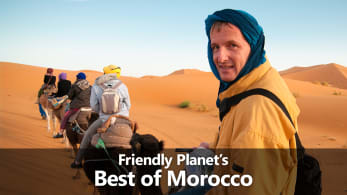 Morocco
Morocco
Morocco encapsulates magic and mystery, unlike any other country. Riding camel back into the Saharan desert sunset, sipping on a steaming cup of mint tea, and navigating your way through maze-like souks are just a few unforgettable experiences you will encounter. From snake charmers and storytellers to magic genie lamps and fire-eaters, travelers worldwide find themselves immersed in this unimaginable destination.
Tours & Packages
- Destinations: Morocco
- including closed packages
Trip Reviews & Photos
We love hearing your stories and seeing your photos! Check out our entire fan photo gallery and upload your photos.
Highlights
- Casablanca
Located on Morocco's Atlantic coast, Casablanca is the modern heart of Morocco. This port city is the country's largest city as well as the busiest port, accumulating a population of over 3.5 million residents! Casablanca is a thriving business center composed of bustling restaurants, nightclubs, and art venues. The city's most recognizable landmark is the Great Hassan II Mosque and its towering 700-foot-tall minaret. One of the largest mosques in the world, the Hassan II Mosque is full of intricate mosaics, carved wooden ceilings, and overall breathtaking beauty. The construction of this fascinating masterpiece took over seven years and 10,000 craftsmen. Casablanca is also home to Mohamed V Square, the United Nations Place, the Habous Quarter, Notre Dame de Lourdes Cathedral, and the residential area of Anfa.
- Sahara Desert
Visiting the Sahara Desert is certainly a bucket list item to check off. The Sahara is the world's largest hot desert and third-largest. The desert is so large that it nearly covers a third of the entire continent of Africa and is almost the size of the United States! Although the topography is known for its imposing dunes (some reaching nearly 600 feet high), they only cover about 15% of the entire desert. Other features include mountains, salt flats, basins, and depressions. This hot and arid area is home to over 500 species of plants and over 200 animal species, camels being the most iconic animal to roam the Sahara. The average temperature for the desert lingers around 86°F, with a record of reaching 136°F!
- Todra Gorge Canyon
The Todra Gorge Canyon is composed of a series of limestone river canyons on the eastern side of the High Atlas Mountains. The Todra and Dades Rivers created this canyon, once flowing 25 miles through the towering cliffs and have since dried up, leaving behind a narrow track only 10 meters wide. The Todra Gorge is recognized worldwide as one of the most spectacular canyons, and for a good reason. The gorge stretches 33 feet in some canyon areas but skyrockets more than 500 feet tall! Although the canyon is located in a remote area in Morocco, it remains a popular tourist destination, allowing travelers to hike through the curving paths and take advantage of the incredible photo opportunities.
- Mint Tea
Tea is, hands-down, Morocco's most beloved beverage. The act of brewing and sipping on a steaming cup of tea is a long-lived tradition that symbolizes hospitality and friendship. Tea was introduced to Morocco in the late 1600s but became popular in the mid-19th century. In the mid-1800s, tea was seen as a luxury and became an everyday staple for all classes in the early 1880s. Although many teas are enjoyed, the most iconic is mint tea. Moroccan mint tea is a golden-amber-colored green tea prepared with spearmint leaves and sugar, providing a perfect balance of strength, sweetness, and mintiness. Mint tea is served throughout the day, especially at mealtimes. While the woman of the house prepares the food, the tea is often brewed by the man and is considered an exquisite art passed down through generations.
- Fez
Fez is Morocco's ancient cultural capital, full of a variety of bustling cafes, outdoor markets, exotic souks, and more. This area of Morocco is famous for its walled city, Fez el Bali. Designated as a UNESCO World Heritage Site, the city is the best-preserved medina in the Arab world, the world's most significant car-free urban space. It is also home to the world's oldest university. A trip to Fez's medina will not disappoint as you wander through the estimated 9,500 streets full of vibrant souks. Admire the countless artisan and merchant stands, surrounding yourself with the sights and smells of colorful and aromatic spices, fresh and dried fruits, hand-made clothing, and shiny genie lamps. The medieval center of Fez has not changed for centuries and is an ancient place where traditions are still practiced in everyday life.
- Souks
A souk is a traditional marketplace usually separated into various sections for different trades where travelers can discover the real Morocco. From vendors selling spices and herbs to pottery and leather goods, you will find no shortage of treasures! Located on popular trading routes, people journey through here from all directions, with merchants often traveling by camel or donkey. Tourists are drawn to the narrow, curving streets to experience the bustle and charm of these souks, where locals rely on them for their everyday essentials. In addition to many vendor stalls, prepare to witness storytellers, snake charmers, and fire-eaters in the open-air market, showcasing the magic that encapsulates Morocco. A crucial part of shopping in the souks is haggling. Negotiating the prices of goods should be done in a friendly manner, and be bold and walk away if a final price cannot be agreed upon.
- Volubilis Roman Ruins
Volubilis is one of Morocco's best-preserved Roman ruins between Fez and Meknes' cities. It is said that the big walled city, full of grand residences and stunning mosaic tile work, was once home to over 20,000 residents. In the 1800s, the Lisbon Earthquake targeted the region, leaving the buildings in ruins. In the late 1990s, Volubilis was marked as a UNESCO World Heritage site. The unimaginable beauty of the building remains illustrates the importance of Volubilis. The Basilica was once one of the finest Roman basilicas in Africa that stood as the city's legal administration, standing two stories high before the destruction. Beside it was the Capitoline Temple that was built in dedication to the Roman state's trinity of divinities. Finally, the stunning Decumanus Maximus represented the commercial heart of Volubilis, once holding dozens of shops in the upper-class neighborhood. Today, admire the stone blocks covered in images, which would have served as signs for the numerous shops.
Fast Facts
Already booked on one of our packages to Morocco? See everything you need to know before you go.
| Overview | Capital: Rabat |
| Entry requirements | Please see our Entry Requirements page. |
| Staying Healthy | Immunizations are NOT currently required for travel to Morocco. However, you may wish to consult your personal physician or local public health authorities as to their suggestions on other health concerns or requirements. |
| Weather | Morocco generally has a sub-tropical and diverse climate depending on the region and season. October-December and March-May are Morocco’s best seasons, when temperatures average in the low 70s F/24 C. January and February can be cool and rainy. Because of the generally moderate or warm climate, most of the hotels do not have central heating. During summer, the average temperature in Marrakesh and Fez is around the 100’s; while the coastal cities of Casablanca, Rabat and Tangier have an average temperature in the low 80s. South of the Atlas Mountains, temperatures increase greatly. |
| What to wear | Since Morocco is primarily a Muslim country, customs will be different from what you are accustomed to in the USA. When visiting mosques and for touring, you should plan to dress modestly with shoulders and knees covered. Despite the heat, it is still preferred that women do not wear shorts or halter-style tops. Jeans and slacks, skirts or culottes are recommended. Loose-fitting shirts or tunics are also appropriate. At mosques and other sacred sites, please dress appropriately - long sleeves or a shawl to cover arms and shoulders, long, loose-fitting, ankle-length trousers (or skirts). Avoid transparent or see-through clothing. Since weather can be unpredictable anywhere in the world, we suggest a folding umbrella or poncho and sweater/ jacket or clothing that can be worn in layers, so that you are prepared for all weather conditions. Bring a sun hat, sunblock, sunglasses, and some tissues or wipes. Remember that comfort and convenience should dictate your wardrobe, and casual clothes are fine most every occasion as you travel. |
| Money & Credit Cards | The official currency in Morocco is the Moroccan dirham. Hotels and some stores accept credit cards (Visa and Master Card only). Please note, credit card transactions are subject to 3% surcharge. For “street shopping” you will need local currency for most transactions (USD is only sometimes accepted). Hotels, banks and foreign exchange bureaus will be able to exchange cash to local currency. We highly recommend that you bring along crisp, new bills. Old, torn, crumpled bills may not be accepted. Be sure to call your credit card providers to let them know you will be traveling abroad, the places you’ll be visiting, and the dates of your trip. This is important for your own protection. For small purchases, we recommend that you use the ATM machines to get cash in local currency so that you can avoid using your credit card in unknown shops where there is a higher risk of having your credit card numbers “borrowed” for unauthorized purchases. Traveler’s checks are no longer accepted in Morocco. Expect to use cash or credit cards for your purchases. Always notify your bank prior to departure to avoid any problems using your credit or debit card while traveling. |
| Shopping | You will have ample opportunity during your visit to Morocco to shop for souvenirs, including artwork, handicrafts and even jewelry. If you purchase such items, do so with the understanding that these items may not have the same high value you were led to believe. And you may be unable to return these items later for a refund. A good rule of thumb when shopping abroad is to choose items that you love and that will remind you of the destination. If you want to shop for high value items, better do so from a trusted merchant at home unless the pleasure of the happy memory of your trip will keep you from regretting your purchase. While we take great care in arranging the components of your tour, we have no relationship with the shopping venues you’ll encounter, and we cannot be liable for any purchases you make. Your guides will no doubt have some favorite shopping places, where the vendors are known, provide good quality merchandise and probably pay some sort of commission from sales to the guide. This should not surprise or offend you, as this is how business is done throughout Morocco and other regions around the world. Please keep in mind that many, if not most stores outside the U.S. will not allow exchanges or refunds for your purchased items. You, as the buyer, assume the full risk in the purchases you make. Tips for Bargaining: Bargaining is a way of life in Morocco. If you want to purchase something, whether in a shop or a souk (or bazaar) and you think the price you’ve been quoted is too high, thank the vendor and walk away. Generally, he/she will come after you with a lower price. It is usually considered good bargaining policy to offer half the asking price, and negotiate from there. The negotiations should be done in a respectful way. |
| Electricity & Power Adapters | 220 volts. Plugs C & E. You will need a voltage converter and plug adapter in order to use U.S. appliances. We recommend getting a universal adapter and converter kit. Learn more about electrical standards around the world. |
| Cell Phones & Internet | Want to take your cell phone, tablet or laptop, but not sure how to get cell service or wifi? Read up on using your cell phone abroad and the top 5 ways to get Internet abroad. |
| Photography | Expect to pay a small fee to bring your camera inside the monuments, temples, tombs and museums. Once inside, flash photography is generally forbidden. Be sure to ask permission before taking pictures of people or animals. It is not unusual for a camel’s owner to ask for a small fee if he sees you taking a picture of his camel. Cameras and video recorders are permitted, and photography is generally permitted everywhere except at airports and military installations. Memory cards for digital cameras will be available in major cities, but you might end up paying a premium. It’s better to bring a spare memory card, saving both time and money. |
| Did you know? |
|

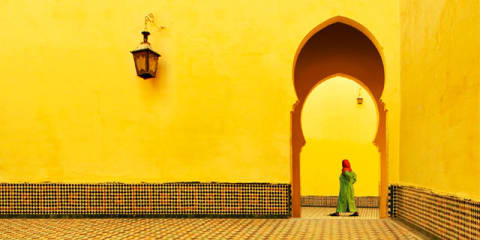
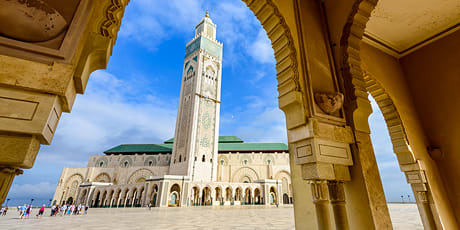 Located on Morocco's Atlantic coast, Casablanca is the modern heart of Morocco. This port city is the country's largest city as well as the busiest port, accumulating a population of over 3.5 million residents! Casablanca is a thriving business center composed of bustling restaurants, nightclubs, and art venues. The city's most recognizable landmark is the Great Hassan II Mosque and its towering 700-foot-tall minaret. One of the largest mosques in the world, the Hassan II Mosque is full of intricate mosaics, carved wooden ceilings, and overall breathtaking beauty. The construction of this fascinating masterpiece took over seven years and 10,000 craftsmen. Casablanca is also home to Mohamed V Square, the United Nations Place, the Habous Quarter, Notre Dame de Lourdes Cathedral, and the residential area of Anfa.
Located on Morocco's Atlantic coast, Casablanca is the modern heart of Morocco. This port city is the country's largest city as well as the busiest port, accumulating a population of over 3.5 million residents! Casablanca is a thriving business center composed of bustling restaurants, nightclubs, and art venues. The city's most recognizable landmark is the Great Hassan II Mosque and its towering 700-foot-tall minaret. One of the largest mosques in the world, the Hassan II Mosque is full of intricate mosaics, carved wooden ceilings, and overall breathtaking beauty. The construction of this fascinating masterpiece took over seven years and 10,000 craftsmen. Casablanca is also home to Mohamed V Square, the United Nations Place, the Habous Quarter, Notre Dame de Lourdes Cathedral, and the residential area of Anfa.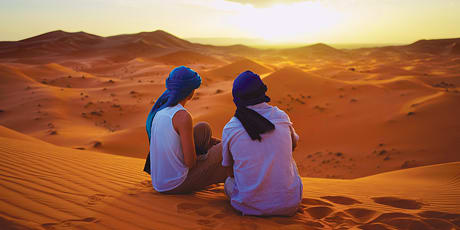 Visiting the Sahara Desert is certainly a bucket list item to check off. The Sahara is the world's largest hot desert and third-largest. The desert is so large that it nearly covers a third of the entire continent of Africa and is almost the size of the United States! Although the topography is known for its imposing dunes (some reaching nearly 600 feet high), they only cover about 15% of the entire desert. Other features include mountains, salt flats, basins, and depressions. This hot and arid area is home to over 500 species of plants and over 200 animal species, camels being the most iconic animal to roam the Sahara. The average temperature for the desert lingers around 86°F, with a record of reaching 136°F!
Visiting the Sahara Desert is certainly a bucket list item to check off. The Sahara is the world's largest hot desert and third-largest. The desert is so large that it nearly covers a third of the entire continent of Africa and is almost the size of the United States! Although the topography is known for its imposing dunes (some reaching nearly 600 feet high), they only cover about 15% of the entire desert. Other features include mountains, salt flats, basins, and depressions. This hot and arid area is home to over 500 species of plants and over 200 animal species, camels being the most iconic animal to roam the Sahara. The average temperature for the desert lingers around 86°F, with a record of reaching 136°F!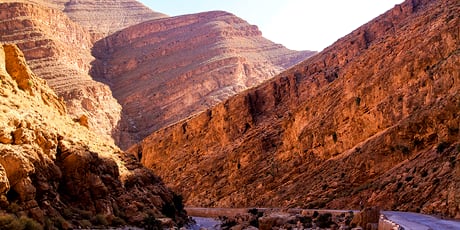 The Todra Gorge Canyon is composed of a series of limestone river canyons on the eastern side of the High Atlas Mountains. The Todra and Dades Rivers created this canyon, once flowing 25 miles through the towering cliffs and have since dried up, leaving behind a narrow track only 10 meters wide. The Todra Gorge is recognized worldwide as one of the most spectacular canyons, and for a good reason. The gorge stretches 33 feet in some canyon areas but skyrockets more than 500 feet tall! Although the canyon is located in a remote area in Morocco, it remains a popular tourist destination, allowing travelers to hike through the curving paths and take advantage of the incredible photo opportunities.
The Todra Gorge Canyon is composed of a series of limestone river canyons on the eastern side of the High Atlas Mountains. The Todra and Dades Rivers created this canyon, once flowing 25 miles through the towering cliffs and have since dried up, leaving behind a narrow track only 10 meters wide. The Todra Gorge is recognized worldwide as one of the most spectacular canyons, and for a good reason. The gorge stretches 33 feet in some canyon areas but skyrockets more than 500 feet tall! Although the canyon is located in a remote area in Morocco, it remains a popular tourist destination, allowing travelers to hike through the curving paths and take advantage of the incredible photo opportunities. 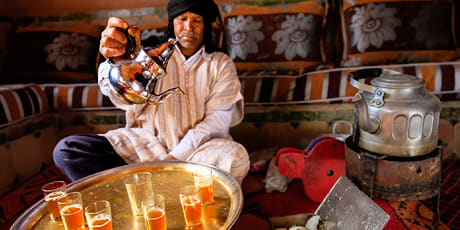 Tea is, hands-down, Morocco's most beloved beverage. The act of brewing and sipping on a steaming cup of tea is a long-lived tradition that symbolizes hospitality and friendship. Tea was introduced to Morocco in the late 1600s but became popular in the mid-19th century. In the mid-1800s, tea was seen as a luxury and became an everyday staple for all classes in the early 1880s. Although many teas are enjoyed, the most iconic is mint tea. Moroccan mint tea is a golden-amber-colored green tea prepared with spearmint leaves and sugar, providing a perfect balance of strength, sweetness, and mintiness. Mint tea is served throughout the day, especially at mealtimes. While the woman of the house prepares the food, the tea is often brewed by the man and is considered an exquisite art passed down through generations.
Tea is, hands-down, Morocco's most beloved beverage. The act of brewing and sipping on a steaming cup of tea is a long-lived tradition that symbolizes hospitality and friendship. Tea was introduced to Morocco in the late 1600s but became popular in the mid-19th century. In the mid-1800s, tea was seen as a luxury and became an everyday staple for all classes in the early 1880s. Although many teas are enjoyed, the most iconic is mint tea. Moroccan mint tea is a golden-amber-colored green tea prepared with spearmint leaves and sugar, providing a perfect balance of strength, sweetness, and mintiness. Mint tea is served throughout the day, especially at mealtimes. While the woman of the house prepares the food, the tea is often brewed by the man and is considered an exquisite art passed down through generations.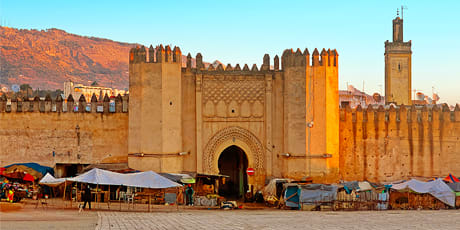 Fez is Morocco's ancient cultural capital, full of a variety of bustling cafes, outdoor markets, exotic souks, and more. This area of Morocco is famous for its walled city, Fez el Bali. Designated as a UNESCO World Heritage Site, the city is the best-preserved medina in the Arab world, the world's most significant car-free urban space. It is also home to the world's oldest university. A trip to Fez's medina will not disappoint as you wander through the estimated 9,500 streets full of vibrant souks. Admire the countless artisan and merchant stands, surrounding yourself with the sights and smells of colorful and aromatic spices, fresh and dried fruits, hand-made clothing, and shiny genie lamps. The medieval center of Fez has not changed for centuries and is an ancient place where traditions are still practiced in everyday life.
Fez is Morocco's ancient cultural capital, full of a variety of bustling cafes, outdoor markets, exotic souks, and more. This area of Morocco is famous for its walled city, Fez el Bali. Designated as a UNESCO World Heritage Site, the city is the best-preserved medina in the Arab world, the world's most significant car-free urban space. It is also home to the world's oldest university. A trip to Fez's medina will not disappoint as you wander through the estimated 9,500 streets full of vibrant souks. Admire the countless artisan and merchant stands, surrounding yourself with the sights and smells of colorful and aromatic spices, fresh and dried fruits, hand-made clothing, and shiny genie lamps. The medieval center of Fez has not changed for centuries and is an ancient place where traditions are still practiced in everyday life. 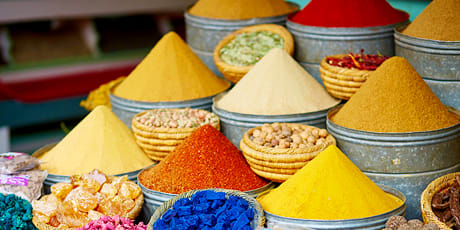 A souk is a traditional marketplace usually separated into various sections for different trades where travelers can discover the real Morocco. From vendors selling spices and herbs to pottery and leather goods, you will find no shortage of treasures! Located on popular trading routes, people journey through here from all directions, with merchants often traveling by camel or donkey. Tourists are drawn to the narrow, curving streets to experience the bustle and charm of these souks, where locals rely on them for their everyday essentials. In addition to many vendor stalls, prepare to witness storytellers, snake charmers, and fire-eaters in the open-air market, showcasing the magic that encapsulates Morocco. A crucial part of shopping in the souks is haggling. Negotiating the prices of goods should be done in a friendly manner, and be bold and walk away if a final price cannot be agreed upon.
A souk is a traditional marketplace usually separated into various sections for different trades where travelers can discover the real Morocco. From vendors selling spices and herbs to pottery and leather goods, you will find no shortage of treasures! Located on popular trading routes, people journey through here from all directions, with merchants often traveling by camel or donkey. Tourists are drawn to the narrow, curving streets to experience the bustle and charm of these souks, where locals rely on them for their everyday essentials. In addition to many vendor stalls, prepare to witness storytellers, snake charmers, and fire-eaters in the open-air market, showcasing the magic that encapsulates Morocco. A crucial part of shopping in the souks is haggling. Negotiating the prices of goods should be done in a friendly manner, and be bold and walk away if a final price cannot be agreed upon.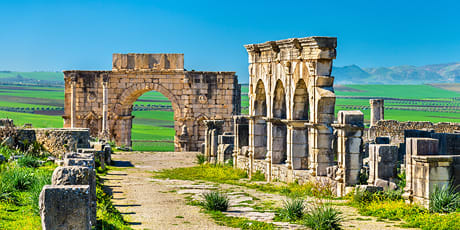 Volubilis is one of Morocco's best-preserved Roman ruins between Fez and Meknes' cities. It is said that the big walled city, full of grand residences and stunning mosaic tile work, was once home to over 20,000 residents. In the 1800s, the Lisbon Earthquake targeted the region, leaving the buildings in ruins. In the late 1990s, Volubilis was marked as a UNESCO World Heritage site. The unimaginable beauty of the building remains illustrates the importance of Volubilis. The Basilica was once one of the finest Roman basilicas in Africa that stood as the city's legal administration, standing two stories high before the destruction. Beside it was the Capitoline Temple that was built in dedication to the Roman state's trinity of divinities. Finally, the stunning Decumanus Maximus represented the commercial heart of Volubilis, once holding dozens of shops in the upper-class neighborhood. Today, admire the stone blocks covered in images, which would have served as signs for the numerous shops.
Volubilis is one of Morocco's best-preserved Roman ruins between Fez and Meknes' cities. It is said that the big walled city, full of grand residences and stunning mosaic tile work, was once home to over 20,000 residents. In the 1800s, the Lisbon Earthquake targeted the region, leaving the buildings in ruins. In the late 1990s, Volubilis was marked as a UNESCO World Heritage site. The unimaginable beauty of the building remains illustrates the importance of Volubilis. The Basilica was once one of the finest Roman basilicas in Africa that stood as the city's legal administration, standing two stories high before the destruction. Beside it was the Capitoline Temple that was built in dedication to the Roman state's trinity of divinities. Finally, the stunning Decumanus Maximus represented the commercial heart of Volubilis, once holding dozens of shops in the upper-class neighborhood. Today, admire the stone blocks covered in images, which would have served as signs for the numerous shops.